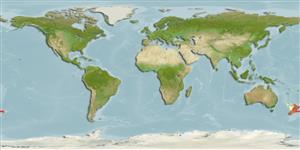Holocephali (chimaeras) >
Chimaeriformes (Chimaeras) >
Chimaeridae (Shortnose chimaeras or ratfishes)
Etymology: Hydrolagus: hydro-, combining form of hydor (Gr.), water; lagos (Gr.), hare, i.e., “water rabbit,” probably referring to three pairs of tooth plates, which tend to protrude from the mouth like a rabbit’s incisors. (See ETYFish); novaezealandiae: novus (L.), new, i.e., of New Zealand, in whose waters it occurs. (See ETYFish).
More on author: Fowler.
Environment: milieu / climate zone / depth range / distribution range
Ecology
Marine; bathydemersal; depth range 25 - 950 m (Ref. 26346), usually 100 - 600 m (Ref. 89422). Deep-water; 34°S - 47°S
Southwest Pacific: endemic to New Zealand.
Size / Weight / Age
Maturity: Lm ? range ? - ? cm
Max length : 96.0 cm TL male/unsexed; (Ref. 26346); common length : 55.0 cm TL male/unsexed; (Ref. 9258)
Short description
Identification keys | Morphology | Morphometrics
Inhabits the outer continental shelf and upper slope (Ref. 26346). Feeds on crustaceans, shellfish, worms and small fish (Ref. 26346). Maximum length 87 cm without tail filament (Ref. 26346), assumed to have 96 cm TL. Marketed as fillets (Ref. 26346).
Life cycle and mating behavior
Maturities | Reproduction | Spawnings | Egg(s) | Fecundities | Larvae
Oviparous, young hatch from egg case at about 9-12 cm (Ref. 26346).
Cox, G. and M. Francis, 1997. Sharks and rays of New Zealand. Canterbury Univ. Press, Univ. of Canterbury. 68 p. (Ref. 26346)
IUCN Red List Status (Ref. 130435)
Threat to humans
Harmless
Human uses
Fisheries: minor commercial
Tools
Special reports
Download XML
Internet sources
Estimates based on models
Preferred temperature (Ref.
123201): 8 - 13.7, mean 10.8 °C (based on 62 cells).
Phylogenetic diversity index (Ref.
82804): PD
50 = 0.5000 [Uniqueness, from 0.5 = low to 2.0 = high].
Bayesian length-weight: a=0.00240 (0.00122 - 0.00472), b=3.14 (2.96 - 3.32), in cm total length, based on LWR estimates for this species & (Sub)family-body (Ref.
93245).
Trophic level (Ref.
69278): 3.5 ±0.46 se; based on food items.
Resilience (Ref.
120179): Low, minimum population doubling time 4.5 - 14 years (Assuming Fec <100).
Prior r = 0.28, 95% CL = 0.19 - 0.42, Based on 1 data-limited stock assessment.
Fishing Vulnerability (Ref.
59153): High vulnerability (58 of 100).
Climate Vulnerability (Ref.
125649): Very high vulnerability (76 of 100).
Nutrients (Ref.
124155): Calcium = 11.4 [3.1, 38.0] mg/100g; Iron = 0.389 [0.134, 0.967] mg/100g; Protein = 15.9 [10.4, 19.0] %; Omega3 = 0.266 [0.100, 0.709] g/100g; Selenium = 18 [5, 59] μg/100g; VitaminA = 6.22 [1.30, 27.04] μg/100g; Zinc = 0.326 [0.172, 0.627] mg/100g (wet weight);
